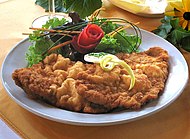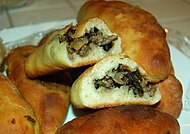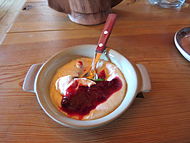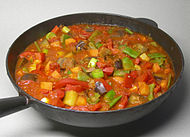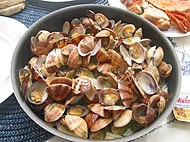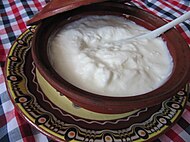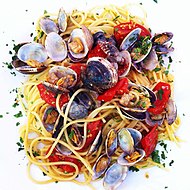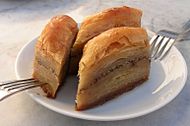European cuisine


European cuisine, or alternatively Western cuisine, is a generalised term collectively referring to the cuisines of Europe[1] and other Western countries,[2] including (depending on the definition) that of Russia,[2] as well as non-indigenous cuisines of Australasia, the Americas, Southern Africa, and Oceania, which derive substantial influence from European settlers in those regions. The term is used by East Asians to contrast with Asian styles of cooking.[3] (This is analogous to Westerners' referring collectively to the cuisines of East Asian countries as Asian cuisine.) When used by Westerners, the term may sometimes refer more specifically to cuisine in Europe; in this context, a synonym is Continental cuisine, especially in British English.


The cuisines of Western countries are diverse by themselves, although there are common characteristics that distinguish Western cooking from cuisines of Asian countries[4] and others. Compared with traditional cooking of Asian countries, for example, meat is more prominent and substantial in serving-size.[5] Steak and cutlet in particular are common dishes across the West. Western cuisines also put substantial emphasis on grape wine and on sauces as condiments, seasonings, or accompaniments (in part due to the difficulty of seasonings penetrating the often larger pieces of meat used in Western cooking). Many dairy products are utilised in the cooking process, except in nouvelle cuisine.[6] Cheeses are produced in hundreds of different varieties, and fermented milk products are also available in a wide selection. Wheat-flour bread has long been the most common source of starch in this cuisine, along with pasta, dumplings and pastries, although the potato has become a major starch plant in the diet of Europeans and their diaspora since the European colonisation of the Americas. Maize is much less common in most European diets than it is in the Americas; however corn meal (polenta or mămăligă), is a major part of the cuisine of Italy and the Balkans. Although flatbreads (especially with toppings such as pizza or tarte flambée), and rice are eaten in Europe, they do not constitute an ever-present staple. Salads (cold dishes with uncooked or cooked vegetables with sauce) are an integral part of European cuisine.
Formal European dinners are served in distinct courses. European presentation evolved from service à la française, or bringing multiple dishes to the table at once, into service à la russe, where dishes are presented sequentially. Usually, cold, hot and savoury, and sweet dishes are served strictly separately in this order, as hors d'oeuvre (appetizer) or soup, as entrée and main course, and as dessert. Dishes that are both sweet and savoury were common earlier in ancient Roman cuisine, but are today uncommon, with sweet dishes being served only as dessert. A service where the guests are free to take food by themselves is termed a buffet, and is usually restricted to parties or holidays. Nevertheless, guests are expected to follow the same pattern.
Historically, European cuisine has been developed in the European royal and noble courts. European nobility was usually arms-bearing and lived in separate manors in the countryside. The knife was the primary eating implement (cutlery), and eating steaks and other foods that require cutting followed. In contrast in the Sinosphere, the ruling class were the court officials, who had their food cut ready to eat in the kitchen, to be eaten with chopsticks. The knife was supplanted by the spoon for soups, while the fork was introduced later in the early modern period, ca. 16th century. Today, eating dinner by hand (without cutlery) is no longer considered acceptable.
Central European cuisines
All of these countries have their specialities. Austria is famous for their Wiener Schnitzel - a breaded veal cutlet served with gravy, the Czech Republic for their world renowned beers. Germany for their world famous wursts, Hungary for their goulash. Slovakia is famous for their gnocchi-like Halusky pasta. Slovenia for their German and Italian influenced cuisine, Poland for their world famous Pierogis which are a cross between a Ravioli and an Empanada. Liechtenstein and German speaking Switzerland are famous for their Rösti and French speaking Switzerland for their Raclettes.
 Austrian cuisine
Austrian cuisine Czech cuisine
Czech cuisine German cuisine
German cuisine Hungarian cuisine
Hungarian cuisine Polish cuisine
Polish cuisine Liechtensteiner cuisine
Liechtensteiner cuisine Slovak cuisine
Slovak cuisine Slovenian cuisine
Slovenian cuisine Swiss cuisine
Swiss cuisine
-
Austrian Wiener Schnitzel
-
Slovenian žganci
-
Swiss fondue
-
Czech Vepřo-knedlo-zelo
-
German Sauerbraten with potato dumplings
-
German Black Forest cake
-
Hungarian gulyás
-
Polish pierogi
-
Slovakian Skalický trdelník
-
Slovakian Bryndzové halušky
-
Slovenian Prekmurska gibanica
Eastern European cuisines
 Armenian cuisine
Armenian cuisine Azerbaijani cuisine
Azerbaijani cuisine Belarusian cuisine
Belarusian cuisine Georgian cuisine
Georgian cuisine Russian cuisine
Russian cuisine
 Ukrainian cuisine
Ukrainian cuisine
-
Azerbaijani plov
-
Belarusian potato babka
-
Crimean Tatar chiburekki
-
Georgian chanakhi
-
Russian pirozhki
-
Russian Olivier salad
-
Tatar azu (veal stew)
-
Ukrainian borscht
Northern European cuisines
 British cuisine
British cuisine
 Danish cuisine
Danish cuisine Estonian cuisine
Estonian cuisine Faroese cuisine
Faroese cuisine Finnish cuisine
Finnish cuisine Greenlandic cuisine
Greenlandic cuisine Icelandic cuisine
Icelandic cuisine Irish cuisine
Irish cuisine Latvian cuisine
Latvian cuisine Lithuanian cuisine
Lithuanian cuisine Norwegian cuisine
Norwegian cuisine Swedish cuisine
Swedish cuisine Sami cuisine
Sami cuisine
-
Danish Stegt flæsk med persillesovs
-
English Sunday roast
-
Estonian kama dessert
-
Norwegian fårikål
-
Finnish creamy salmon soup
-
Lithuanian cepelinai
Southern European cuisines
 Albanian cuisine
Albanian cuisine Bosnia and Herzegovina cuisine
Bosnia and Herzegovina cuisine Bulgarian cuisine
Bulgarian cuisine Croatian cuisine
Croatian cuisine Cypriot cuisine
Cypriot cuisine Greek cuisine
Greek cuisine
 Italian cuisine
Italian cuisine
 Occitan cuisine
Occitan cuisine Macedonian cuisine
Macedonian cuisine Maltese cuisine
Maltese cuisine Moldovan cuisine
Moldovan cuisine Montenegrin cuisine
Montenegrin cuisine Portuguese cuisine
Portuguese cuisine Romanian cuisine
Romanian cuisine Serbian cuisine
Serbian cuisine Slovenian cuisine
Slovenian cuisine Spanish cuisine
Spanish cuisine
 Turkish cuisine
Turkish cuisine
Western European cuisines
-
Belgian carbonnade flamande
-
Belgian moules frites
-
French magret
-
Dutch Boerenkoolstamppot with rookworst
-
French fondue savoyarde
-
French quiche lorraine
-
Luxembourgian Quetschentaart
See also
- Early modern European cuisine
- Latin American cuisine
- Medieval cuisine
- Mediterranean cuisine
- Jewish cuisine
References
- ^ Culinary Cultures of Europe: Identity, Diversity and Dialogue. Council of Europe.
- ^ a b "European Cuisine." Europeword.com. Accessed July 2011.
- ^ Leung Man-tao (12 February 2007), "Eating and Cultural Stereotypes", Eat and Travel Weekly, no. 312, p. 76. Hong Kong|publisher=Next Media Limited
- ^ Kwan Shuk-yan (1988). Selected Occidental Cookeries and Delicacies, p. 23. Hong Kong: Food Paradise Pub. Co.
- ^ Lin Ch'ing (1977). First Steps to European Cooking, p. 5. Hong Kong: Wan Li Pub. Co.
- ^ Kwan Shuk-yan, pg 26
- ^ http://www.visiteurope.com/Discover/Where-To-Go/Central-Europe/Cuisine-Central-Europe
- ^ http://foodspring.com/content/central-europe/
Further reading
- Albala, Ken (2003). Food in Early Modern Europe. Greenwood Publishing Group. ISBN 0313319626. Retrieved November 2012.
{{cite book}}: Check date values in:|accessdate=(help); Cite has empty unknown parameter:|coauthors=(help) - R & R Publishing; ; et al. (2005). European Cuisine: The Best in European Food. Cpg Incorporated. ISBN 1740225279. Retrieved November 2012.
{{cite book}}: Check date values in:|accessdate=(help); Cite has empty unknown parameter:|coauthors=(help); Explicit use of et al. in:|last=(help)CS1 maint: multiple names: authors list (link)

